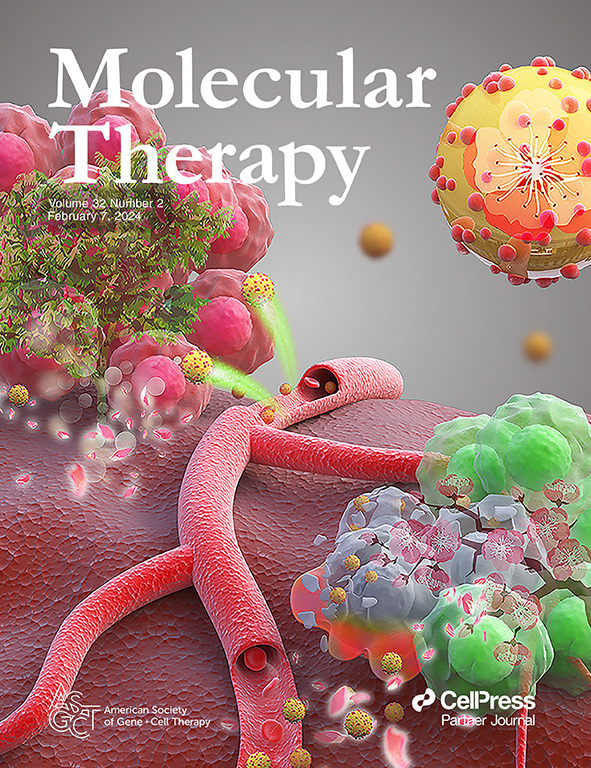NOD小鼠肝脏胰腺转分化可防止高血糖的发生。
IF 12
1区 医学
Q1 BIOTECHNOLOGY & APPLIED MICROBIOLOGY
引用次数: 0
摘要
1型糖尿病(T1D)是由自身免疫破坏胰腺产生胰岛素的β (β)细胞引起的。本研究探讨了一种新的基因治疗方法,通过用转分化肝细胞取代胰腺β细胞功能来预防疾病的发展。采用临床适用的第三代慢病毒载体,将β细胞转录因子(Pdx1、ND1和MafA)混合物递送至5-6周龄非肥胖糖尿病(NOD)小鼠门静脉。在实验终点(30周),100%接受表达三种β细胞转录因子的慢病毒载体的NOD小鼠血糖正常。此外,腹腔内葡萄糖耐量试验显示,治疗NOD小鼠可以像非糖尿病对照动物一样有效地使血糖浓度正常化。RT-PCR检测了一系列胰腺标志物,如生长抑素、Glut 2和最重要的小鼠胰岛素(INS1和INS2),它们也被发现储存在肝脏中。肝功能检查正常总的来说,这些数据表明,这些β细胞转录因子的表达导致了部分胰腺转分化,并阻止了高血糖和异常糖耐量的发展,这是T1D的标志。因此,这种方法作为一种潜在的预防策略具有很大的希望。本文章由计算机程序翻译,如有差异,请以英文原文为准。
Pancreatic Transdifferentiation of NOD Mouse Livers Prevented Development of Hyperglycemia.
Type 1 diabetes (T1D) is caused by the autoimmune destruction of the pancreatic insulin producing beta (β)-cells. This study investigated a novel gene therapy approach to prevent disease development by replacing pancreatic β-cell function with that from transdifferentiated liver cells. A clinically applicable third-generation lentiviral vector was used to deliver a cocktail of β-cell transcription factors (Pdx1, ND1 and MafA) to the portal vein of 5-6-week-old non-obese diabetic (NOD) mice. At the experimental endpoint (30-weeks), 100% of the NOD mice that received the lentiviral vector expressing the three β-cell transcription factors were normoglycemic. Additionally, intraperitoneal glucose tolerance tests revealed that treated NOD mice could normalise blood glucose concentrations as efficiently as non-diabetic control animals. RT-PCR detected a range of pancreatic markers, such as somatostatin, Glut 2 and most importantly mouse insulin (INS1 and INS2), which was also found to be stored in the liver. Liver function tests remained normal. Collectively, this data shows expression of these β-cell transcription factors led to partial pancreatic transdifferentiation and halted the development of hyperglycemia and abnormal glucose tolerance, which are the hallmarks of T1D. Thus, this approach holds substantial promise as a potential prophylactic strategy.
求助全文
通过发布文献求助,成功后即可免费获取论文全文。
去求助
来源期刊

Molecular Therapy
医学-生物工程与应用微生物
CiteScore
19.20
自引率
3.20%
发文量
357
审稿时长
3 months
期刊介绍:
Molecular Therapy is the leading journal for research in gene transfer, vector development, stem cell manipulation, and therapeutic interventions. It covers a broad spectrum of topics including genetic and acquired disease correction, vaccine development, pre-clinical validation, safety/efficacy studies, and clinical trials. With a focus on advancing genetics, medicine, and biotechnology, Molecular Therapy publishes peer-reviewed research, reviews, and commentaries to showcase the latest advancements in the field. With an impressive impact factor of 12.4 in 2022, it continues to attract top-tier contributions.
 求助内容:
求助内容: 应助结果提醒方式:
应助结果提醒方式:


